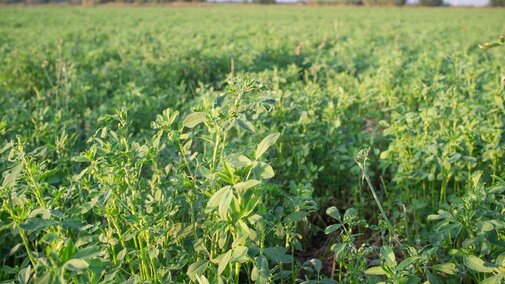Evaluating Alfalfa Stands: Stand Counts
Were you expecting more from last year’s alfalfa yields? Did your plants get enough time to winterize in the fall? Do you have concerns about stand winter kill? Evaluating your alfalfa stand in the spring is key to planning management and setting expectations for this year.
As stands begin greening up, alfalfa stand assessment can be completed using a hay square as a quick and easy way to look at the overall stand health. While we call it a hay square, square or circle shapes work equally well. A 17 by 17-inch square or 19-inch diameter circle are the size needed.
Next, determine what to count. There are two options when evaluating your stand: (1) By the number of plants per square foot (typically recommended for new stands, planted last fall), and (2) by the number of stems for established stands. Stem count will more accurately predict yield compared to plant number. However, either method will provide information for making management decisions.
Randomly select four to five areas in your field to sample. Then count the plants or stems that would be harvested, typically anything over six inches, to determine your count. Then divide those numbers by two to get stems or plants per square foot. For established stands, having four to five healthy plants per square foot or 55 stems per square foot would warrant a productive and healthy stand. Fields with stem counts below 55 see a significant decrease in dry matter production.
For stands planted last fall, you will see more plants per square foot compared to stems. Remember, a good rule of thumb is, for every pound of seed planted, expect three to five plants. New plantings that contain fewer than 12 plants per square foot may need to be reseeded.
Fertilizing Cool-season Grass
Fertilizing cool-season grass pastures or hayfields is something producers do each year while accounting for forage needs, moisture, the value of the forage and fertilizer costs.
Fertilization of smooth bromegrass pastures should occur late March through April. If the nitrogen is a single application, usually between 80 to 100 pounds of actual N per acre is suggested for eastern Nebraska. The recommended application rate declines westward across the state with about 30 to 40 pounds N per acre suggested for the Panhandle.
If doing split applications, usually it's two-thirds in the spring and a third in the fall when growth resumes on the cool-season grasses. With fertilized pasture, be sure to include a rotational grazing plan that will effectively harvest the extra forage and provide the greatest return on the fertilizer investment. Also, remember that adequate moisture is needed with fertilizer applications.
Soil tests could also be conducted to determine more exact amounts needed, particularly for any phosphorus, potassium or sulfur that could be applied.
Research conducted in eastern Nebraska has shown a 30% increase in forage yield with fertilization and the economic optimum rate is between 80 to 120 pounds per acre. A crude protein increase from 16% to 20% was seen with fertilizer applications up to 160 pounds. That is a lot of fertilizer, but it did increase crude protein and organic matter digestibility while decreasing NDF or neutral detergent fiber. Always be aware when applying fertilizer, especially in pastures and fields near water sources such as ponds.
Brome pastures are hardy, and we can and do graze them hard in Nebraska. Haying or grazing operations can benefit if managed correctly with fertilizer.

